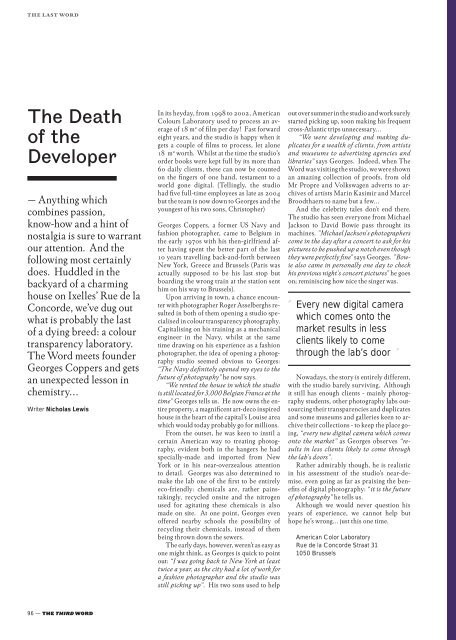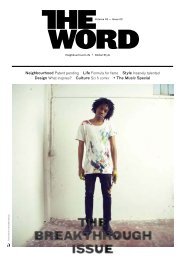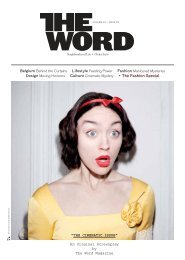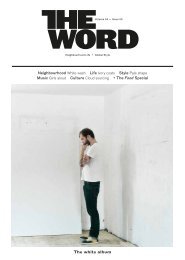download as PDF - The Word Magazine
download as PDF - The Word Magazine
download as PDF - The Word Magazine
You also want an ePaper? Increase the reach of your titles
YUMPU automatically turns print PDFs into web optimized ePapers that Google loves.
the l<strong>as</strong>t word<br />
<strong>The</strong> Death<br />
of the<br />
Developer<br />
— Anything which<br />
combines p<strong>as</strong>sion,<br />
know-how and a hint of<br />
nostalgia is sure to warrant<br />
our attention. And the<br />
following most certainly<br />
does. Huddled in the<br />
backyard of a charming<br />
house on Ixelles’ Rue de la<br />
Concorde, we’ve dug out<br />
what is probably the l<strong>as</strong>t<br />
of a dying breed: a colour<br />
transparency laboratory.<br />
<strong>The</strong> <strong>Word</strong> meets founder<br />
Georges Coppers and gets<br />
an unexpected lesson in<br />
chemistry…<br />
Writer Nichol<strong>as</strong> Lewis<br />
96 — THE THIRD WORD<br />
In its heyday, from 1998 to 2002, American<br />
Colours Laboratory used to process an average<br />
of 18 m 2 of fi lm per day! F<strong>as</strong>t forward<br />
eight years, and the studio is happy when it<br />
gets a couple of fi lms to process, let alone<br />
18 m 2 worth. Whilst at the time the studio’s<br />
order books were kept full by its more than<br />
60 daily clients, these can now be counted<br />
on the fi ngers of one hand, testament to a<br />
world gone digital. (Tellingly, the studio<br />
had fi ve full-time employees <strong>as</strong> late <strong>as</strong> 2004<br />
but the team is now down to Georges and the<br />
youngest of his two sons, Christopher)<br />
Georges Coppers, a former US Navy and<br />
f<strong>as</strong>hion photographer, came to Belgium in<br />
the early 1970s with his then-girlfriend after<br />
having spent the better part of the l<strong>as</strong>t<br />
10 years travelling back-and-forth between<br />
New York, Greece and Brussels (Paris w<strong>as</strong><br />
actually supposed to be his l<strong>as</strong>t stop but<br />
boarding the wrong train at the station sent<br />
him on his way to Brussels).<br />
Upon arriving in town, a chance encounter<br />
with photographer Roger Asselberghs resulted<br />
in both of them opening a studio specialised<br />
in colour transparency photography.<br />
Capitalising on his training <strong>as</strong> a mechanical<br />
engineer in the Navy, whilst at the same<br />
time drawing on his experience <strong>as</strong> a f<strong>as</strong>hion<br />
photographer, the idea of opening a photography<br />
studio seemed obvious to Georges:<br />
“<strong>The</strong> Navy defi nitely opened my eyes to the<br />
future of photography” he now says.<br />
“We rented the house in which the studio<br />
is still located for 3,000 Belgian Francs at the<br />
time” Georges tells us. He now owns the entire<br />
property, a magnifi cent art-deco inspired<br />
house in the heart of the capital’s Louise area<br />
which would today probably go for millions.<br />
From the outset, he w<strong>as</strong> keen to instil a<br />
certain American way to treating photography,<br />
evident both in the hangers he had<br />
specially-made and imported from New<br />
York or in his near-overzealous attention<br />
to detail. Georges w<strong>as</strong> also determined to<br />
make the lab one of the fi rst to be entirely<br />
eco-friendly: chemicals are, rather painstakingly,<br />
recycled onsite and the nitrogen<br />
used for agitating these chemicals is also<br />
made on site. At one point, Georges even<br />
offered nearby schools the possibility of<br />
recycling their chemicals, instead of them<br />
being thrown down the sewers.<br />
<strong>The</strong> early days, however, weren’t <strong>as</strong> e<strong>as</strong>y <strong>as</strong><br />
one might think, <strong>as</strong> Georges is quick to point<br />
out: “I w<strong>as</strong> going back to New York at le<strong>as</strong>t<br />
twice a year, <strong>as</strong> the city had a lot of work for<br />
a f<strong>as</strong>hion photographer and the studio w<strong>as</strong><br />
still picking up”. His two sons used to help<br />
out over summer in the studio and work surely<br />
started picking up, soon making his frequent<br />
cross-Atlantic trips unnecessary…<br />
“We were developing and making duplicates<br />
for a wealth of clients, from artists<br />
and museums to advertising agencies and<br />
libraries” says Georges. Indeed, when <strong>The</strong><br />
<strong>Word</strong> w<strong>as</strong> visiting the studio, we were shown<br />
an amazing collection of proofs, from old<br />
Mr Propre and Volkswagen adverts to archives<br />
of artists Marin K<strong>as</strong>imir and Marcel<br />
Broodthaers to name but a few…<br />
And the celebrity tales don't end there.<br />
<strong>The</strong> studio h<strong>as</strong> seen everyone from Michael<br />
Jackson to David Bowie p<strong>as</strong>s throught its<br />
machines. "Michael Jackson's photographers<br />
come in the day after a concert to <strong>as</strong>k for his<br />
pictures to be pushed up a notch even though<br />
they were perfectly fi ne" says Georges. "Bowie<br />
also came in personally one day to check<br />
his previous night's concert pictures" he goes<br />
on; reminiscing how nice the singer w<strong>as</strong>.<br />
" Every new digital camera<br />
which comes onto the<br />
market results in less<br />
clients likely to come<br />
through the lab’s door "<br />
Nowadays, the story is entirely different,<br />
with the studio barely surviving. Although<br />
it still h<strong>as</strong> enough clients - mainly photography<br />
students, other photography labs outsourcing<br />
their transparencies and duplicates<br />
and some museums and galleries keen to archive<br />
their collections - to keep the place going,<br />
“every new digital camera which comes<br />
onto the market” <strong>as</strong> Georges observes “results<br />
in less clients likely to come through<br />
the lab’s doors”.<br />
Rather admirably though, he is realistic<br />
in his <strong>as</strong>sessment of the studio’s near-demise,<br />
even going <strong>as</strong> far <strong>as</strong> praising the benefi<br />
ts of digital photography: “ it is the future<br />
of photography” he tells us.<br />
Although we would never question his<br />
years of experience, we cannot help but<br />
hope he’s wrong… just this one time.<br />
American Color Laboratory<br />
Rue de la Concorde Straat 31<br />
1050 Brussels
















